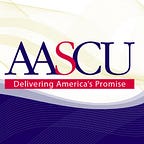Brief Explores Whether Financial Aid Policies Promote Equality or Close Equity Gaps
Examination of students’ education costs and funding resources across populations is imperative for institutions to realize where barriers to access occur and to close financial equity gaps. The first in a series, the American Association of State Colleges and Universities (AASCU) recently released the data brief Do Financial Aid Policies Promote Equality or Close Equity Gaps? that analyzes data for 43,000 dependent students collected from five AASCU institutions to find patterns in cost and aid data.
The brief explores inflation-adjusted costs and aid for the first year of attendance for students first enrolling between 2014–15 and 2018–19. In alignment with AASCU’s strategic goal to partner with our institutions to achieve equitable student outcomes, the brief focuses on cost and aid patterns across race/ethnicity, income, and first-generation status.
The brief finds that while grant aid in its current application begins to equalize out-of-pocket costs across student groups, not all students have the resources to pay the remaining gap, resulting in inequities. Although grants are awarded with more frequency and in larger amounts to low-income and first-generation students and students of color, the amounts are not enough to close the education funding gaps experienced by these students, perpetuating the inequities that already exist. Loans are used by some to cover their funding gap, but others are debt averse.
Here are some highlights from the brief:
Race/Ethnicity
Since grants do not have to be repaid, they are an important type of aid for historically underserved students. The largest share by race/ethnicity, 96% of Native Americans receive grants. Hispanic grant recipients receive the largest amount, averaging $7,958.
Historically underserved students continue to experience the largest financial inequities. For instance, the funding gap for Black and Hispanic students is $6,128 and $6,262, respectively — a significant disadvantage when compared to white students’ average funding surplus of more than $1,000.
Loan usage differs across race/ethnicity. Black and Hispanic students have similarly large funding gaps. However, 64% of Black students take loans, averaging at $5,572, while only 41% of Hispanic students take loans, which average slightly less at $5,111. White students are less likely than average to take loans at 44%, but when they do, the loan is slightly larger than average.
Income
The largest variability in grant aid is across income brackets. Of students from the lowest-income families, 9 in 10 receive grants averaging about $8,600, although 1 in 10 do not receive grant aid, including Pell Grants.
Students in the lowest-income group face the largest funding gap, while students in the highest-income group have a surplus. Students in the lowest-income group have the largest funding gap, averaging $6,698, while students in the highest-income group have a $2,198 surplus.
Across income, loan usage is similar. Slightly more than half, 52%, of low-income students, who have a nearly $6,700 funding gap, take loans at an average of $5,096. This is similar to the share of high-income students with a funding surplus who take loans, although they do so at a slightly higher amount of $5,518.
First-Generation Status
First-generation students are more likely than their counterparts to receive grants. More first-generation students receive grants than those who are non-first-generation students, 84% compared to 73%, respectively.
First-generation students experience funding gaps while non-first-generation students have a surplus. First-generation students have an average funding gap of $3,967, compared to a $1,094 surplus of their non-first-generation peers.
Exploring patterns in student costs and funding resources while reviewing institutional policies and practices can help institutions strategize for how to support students with the greatest financial disadvantages. Notably, the coronavirus pandemic is dramatically affecting and will continue to impact the U.S. economy and higher education, increasing the number of students needing more aid and amplifying the necessity of examining cost and aid data to understand students’ needs.
Read the full brief to gain more details about the analysis and to view questions institutions can ask to facilitate cross-campus conversations about current practices that may perpetuate inequities.
